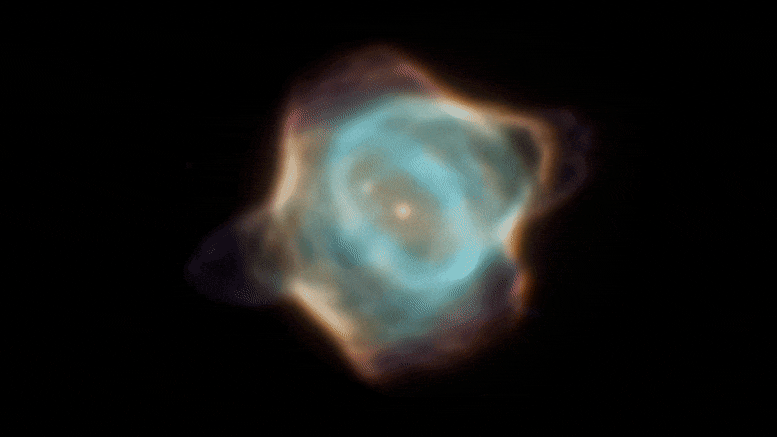
This video shows the drastic changes to the planetary nebula Hen 3-1357, nicknamed the Stingray nebula, over two decades as captured by NASA’s Hubble Space Telescope. The nebula is first seen as it was in 1996, with filaments and tendrils of gas glowing bright blue at its center. The wavy outer edges of gas also stand out against the dark background of the universe. The 1996 portrait then transitions to Hubble’s 2016 image, which shows a much dimmer nebula lacking in the pronounced wavy edges. Credit: NASA, ESA, B. Balick (University of Washington), M. Guerrero (Instituto de Astrofísica de Andalucía), and G. Ramos-Larios (Universidad de Guadalajara), and J. DePasquale (STScI)
Images Spanning 20 Years Reveal Disappearing Nebula
Great things take time. This is true when it comes to many processes in the universe. For example, it takes millions of years for stars—the building blocks of the universe—to form. Then, many stars last for billions of years before they die and begin to eject shells of gas that glow against the vastness of space—what we call nebulas. It can be exceedingly rare to capture some of these processes in real time.
Lucky for us, it seems as if the Stingray nebula, Hen 3-1357, was destined to stand out from the crowd since its beginnings. It was dubbed the youngest known planetary nebula in 1998 after Hubble caught a rare peek at the central star’s final stages of life. Now, twenty years after its first snapshot, the Stingray nebula is capturing the attention of astronomers again for a very different reason.
Images from 2016 show a nebula that has drastically faded over the last two decades. Additionally, shells of gas that surrounded the central star have changed, no longer as crisp as they once were. Changes like this have never been captured at this clarity before.
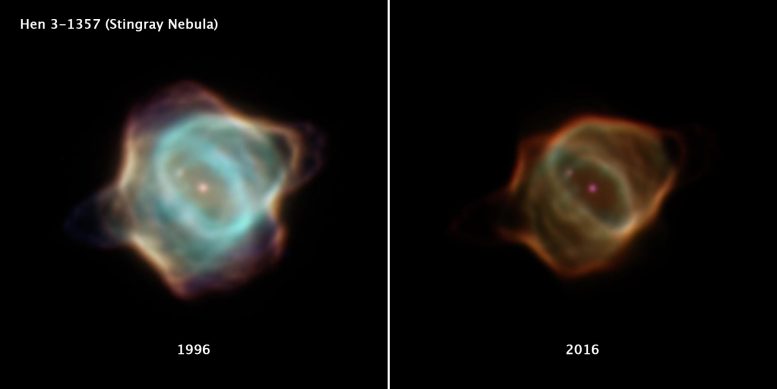
This image compares two drastically different portraits of the Stingray nebula captured by NASA’s Hubble Space Telescope 20 years apart. The image on the left, taken with the Wide Field and Planetary Camera 2 in March 1996, shows the nebula’s central star in the final stages of its life. The gas being puffed off by the dying star is much brighter when compared to the image of the nebula at the right, captured in January 2016 using the Wide Field Camera 3. The Stingray Nebula is located in the direction of the southern constellation Ara (the Altar). Credit: NASA, ESA, B. Balick (University of Washington), M. Guerrero (Instituto de Astrofísica de Andalucía), and G. Ramos-Larios (Universidad de Guadalajara)
Astronomers have caught a rare look at a rapidly fading shroud of gas around an aging star. Archival data from NASA’s Hubble Space Telescope reveal that the nebula Hen 3-1357, nicknamed the Stingray nebula, has faded precipitously over just the past two decades. Witnessing such a swift rate of change in a planetary nebula is exceeding rare, say researchers.
Images captured by Hubble in 2016, when compared to Hubble images taken in 1996, show a nebula that has drastically dimmed in brightness and changed shape. Bright blue fluorescent tendrils and filaments of gas toward the center of the nebula have all but disappeared, and the wavy edges that earned this nebula its aquatic-themed name are virtually gone. The young nebula no longer pops against the black velvet background of the vast universe.
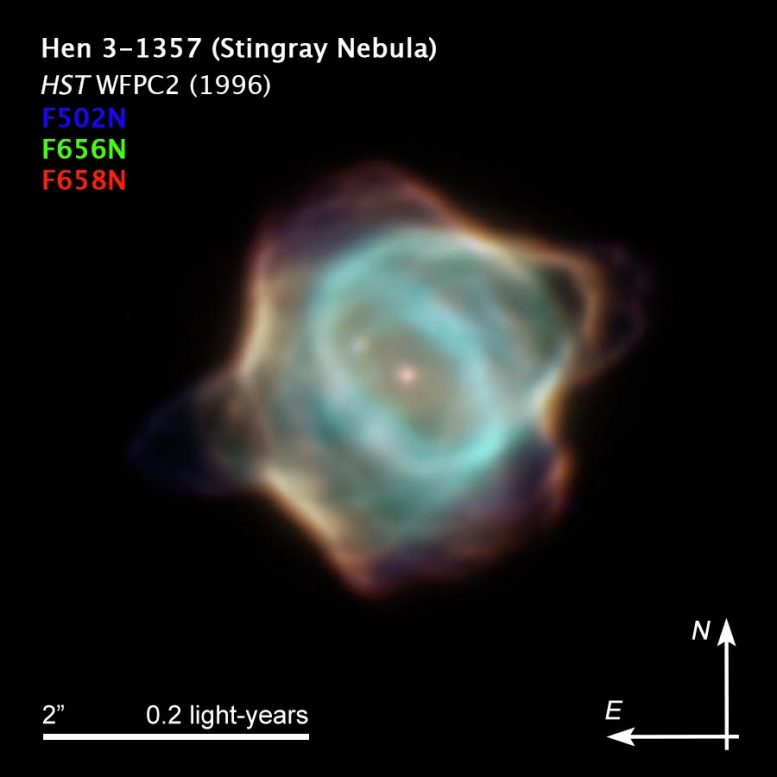
Compass Image for Stingray Nebula in 1996. Credit: NASA, ESA, B. Balick (University of Washington), M. Guerrero (Instituto de Astrofísica de Andalucía), and G. Ramos-Larios (Universidad de Guadalajara)
“This is very, very dramatic, and very weird,” said team member Martín A. Guerrero of the Instituto de Astrofísica de Andalucía in Granada, Spain. “What we’re witnessing is a nebula’s evolution in real-time. In a span of years, we see variations in the nebula. We have not seen that before with the clarity we get with this view.”
Researchers discovered unprecedented changes in the light emitted by glowing nitrogen, hydrogen, and oxygen being blasted off by the dying star at the center of the nebula. The oxygen emission, in particular, dropped in brightness by a factor of nearly 1,000 between 1996 and 2016.
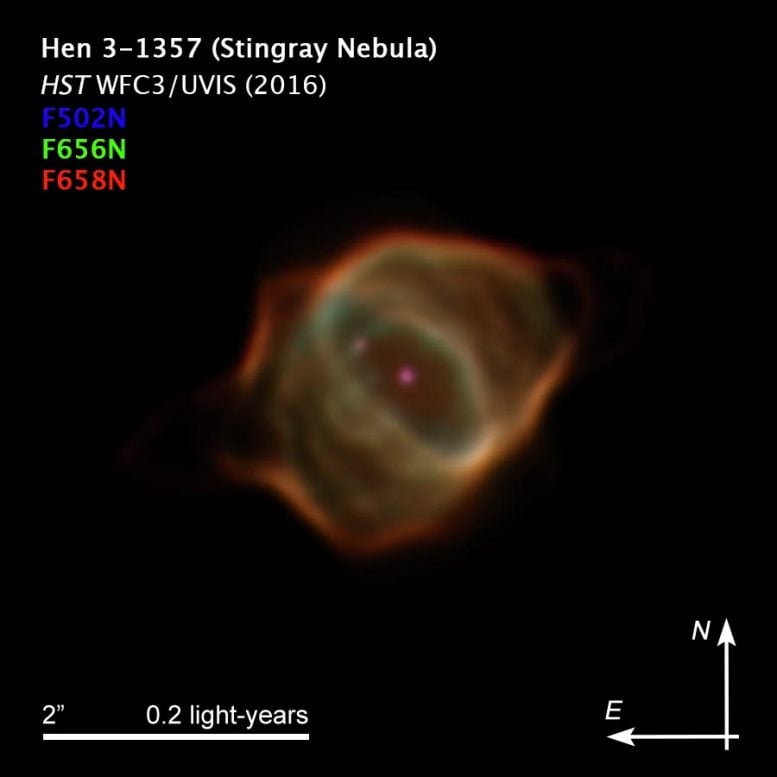
Compass Image for Stingray Nebula in 2016. Credit: NASA, ESA, B. Balick (University of Washington), M. Guerrero (Instituto de Astrofísica de Andalucía), and G. Ramos-Larios (Universidad de Guadalajara)
“Changes in nebulae have been seen before, but what we have here are changes in the fundamental structure of the nebula,” said Bruce Balick of the University of Washington Seattle, leader of the new research. “In most studies, the nebula usually gets bigger. Here, it’s fundamentally changing its shape and getting fainter, and doing so on an unprecedented time scale. Moreover, to our surprise, it’s not growing any larger. Indeed, the once-bright inner elliptical ring seems to be shrinking as it fades.”
Ground-based observations of other planetary nebulae have shown hints of changes in brightness over time, but those speculations haven’t been confirmed until now. Only Hubble can resolve the changes in structure in this tiny nebula. The new paper examines every image of the Stingray Nebula from Hubble’s archives.
“Because of Hubble’s optical stability, we are very, very confident that this nebula is changing in brightness with time,” added Guerrero. “This is something that can only be confirmed with Hubble’s visual acuity.”
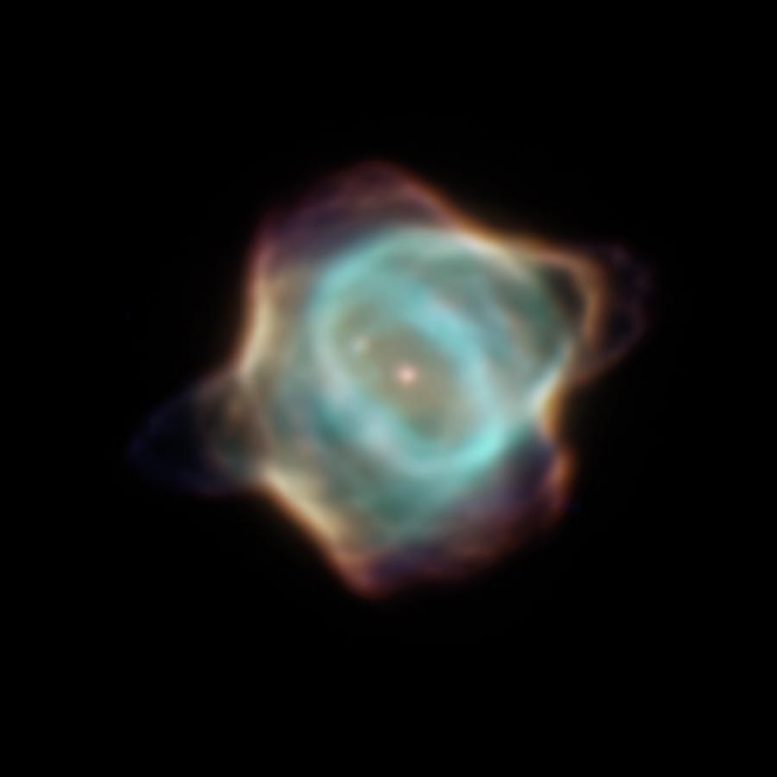
This image shows the planetary nebula Hen 3-1357, nicknamed the Stingray nebula, captured by NASA’s Hubble Space Telescope in March 1996. The image captures the final stages of the central star’s life, where a ballooning shroud of gas is cast off by the dying star. This image captured the Stingray nebula in its infancy and astronomers called it the youngest known planetary nebula. In this image, the colors shown represent light emitted by nitrogen (red), oxygen (green), and hydrogen (blue). Credit: NASA, ESA, B. Balick (University of Washington), M. Guerrero (Instituto de Astrofísica de Andalucía), and G. Ramos-Larios (Universidad de Guadalajara)
The researchers note the nebula’s rapid changes are a response to its central star, SAO 244567, expanding due to a temperature drop, and in turn emitting less ionizing radiation.
A 2016 study by Nicole Reindl now of the University of Potsdam, Germany, and a team of international researchers, also using Hubble data, noted the star at the center of the Stingray nebula, SAO 244567, is special in its own right.
Observations from 1971 to 2002 showed the temperature of the star skyrocketing from less than 40,000 to 108,000 degrees Fahrenheit (22,200 to 60,000 degrees Celsius), more than ten times hotter than the surface of our Sun. Now, Reindl and her research team has shown that SAO 245567 is cooling. Reindl speculates the temperature jump was caused by a brief flash of helium fusion that occurred in a shell around the core of the central star. Recently, the star appears to be backstepping into its early stage of stellar evolution.
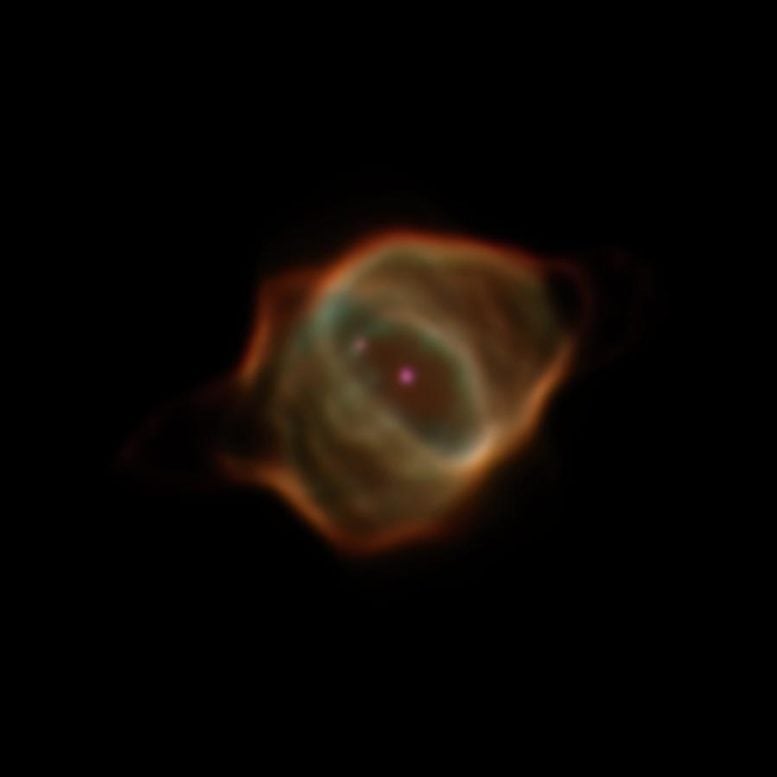
This image shows the planetary nebula Hen 3-1357, nicknamed the Stingray nebula, captured by NASA’s Hubble Space Telescope in January 2016. This image of the Stingray Nebula shows it has changed drastically in brightness and shape when compared to its first portrait by Hubble in 1996. When comparing the imaging, researchers discovered unprecedented changes in the light emitted by glowing nitrogen (shown in red), hydrogen (blue), and oxygen (green) being blasted off by the dying star at the center of the nebula. Credit: NASA, ESA, B. Balick (University of Washington), M. Guerrero (Instituto de Astrofísica de Andalucía), and G. Ramos-Larios (Universidad de Guadalajara)
“We’re very lucky to observe it just in that moment,” said Reindl. “During such a helium shell flash, it evolves very quickly and that implies short evolutionary timescales so we can’t usually see how these stars evolve. We just happened to be there at the right time to have caught that.”
The team studying the rapid fading of the Stingray Nebula can only speculate at this time what’s in store for the future of this young nebula. At its present rate of fading, it’s estimated the nebula will barely be detectable in 20 or 30 years.
The Hubble Space Telescope is a project of international cooperation between NASA and ESA (European Space Agency). NASA’s Goddard Space Flight Center in Greenbelt, Maryland, manages the telescope. The Space Telescope Science Institute (STScI) in Baltimore, Maryland, conducts Hubble science operations. STScI is operated for NASA by the Association of Universities for Research in Astronomy in Washington, D.C.

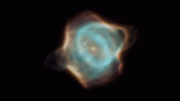
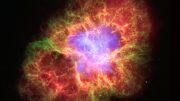
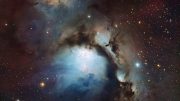
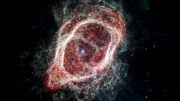
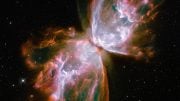
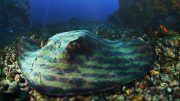
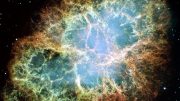

The Stingray Neb. beautiful as it is, is still the same. You cannot clone a camera. Camera 2 should have been used again albeit 20 year on. Who left that smokie thumbprint on the lens of camera 3 anyway?
Hey, Jo! Look at this rainbow!
Do we see the same rainbow?
More than likely, It’s slowly being obfuscated by interstellar dust
Exactly what I was thinking. Same thing happened to Betelgeuse to trick astronomers into thinking it was going to go nova.
very good thanks
Extrmely Interesting.
A nebula is a gaint cloud of dust and gas in Space. Some Nebulae (Plural) form as a result of dying star throwing out a a whole lot of dust and gas in a bright explosion! E.g. Supernova. Others Nebulae are regions where new stars are being born.
The hypothesis being proposed is that if Nebulaes are close to a black hole they are aborbed by the black whole and a new unverse/ anti universe is born in the Mutiverse! If there is no Black Holes nearby this phenomenon being oberved currently of a fading Nebula becomes visible. As its Life span of visibility appears to be miniscule in the lifespan of the Universe it ispossibly a lucky break that we are observing this.
If gas and dust cloud travel the universe and find a black whole which is looking for “Food” it will be abosrbed and expelled in the Multiverse as a cloud of gas and dust in the Multiverse toas a Universe/ Anti Universe!. All “Food” after digestion must find an exit route. Mabe the exit route is the expulsion of the gas and dust on the other side of the Black Hole which could result in the formation of a new Universe/Antiuniverse and star formation and birth of new galaxy’s and stars and planets over a period of time.
Now, if only some bright spark would work out the mathematics of all I have prooposed she/he truly deserves a Nobel Prize!!.
Here is some more food for thought.
Do Anti Black Holes exist? Let is call it White Holes! Work out the mathematics of the speed and acceleration at which the rest of the Universe is seemingly speeding away from us or we from the rest of the Universe in its expansion phase, and the survival instinct of all matter and antimater with or without (“LIFE”) and expain it to the world. At least in mathematical terms!
The Nebula of “Sting Ray” appears to be the result of a CNO dominant Neutrino signature where in its death thores the oxygen is rapidly disappearing and only Carbon and Nitrogen are left behind in the corpse of what was once a very bright star!. Maybe the Proton-Proton dominant Neutrino Stars become Supernova and go out in a great big blast!! Crematorium versus graveyards!! Take your pick.